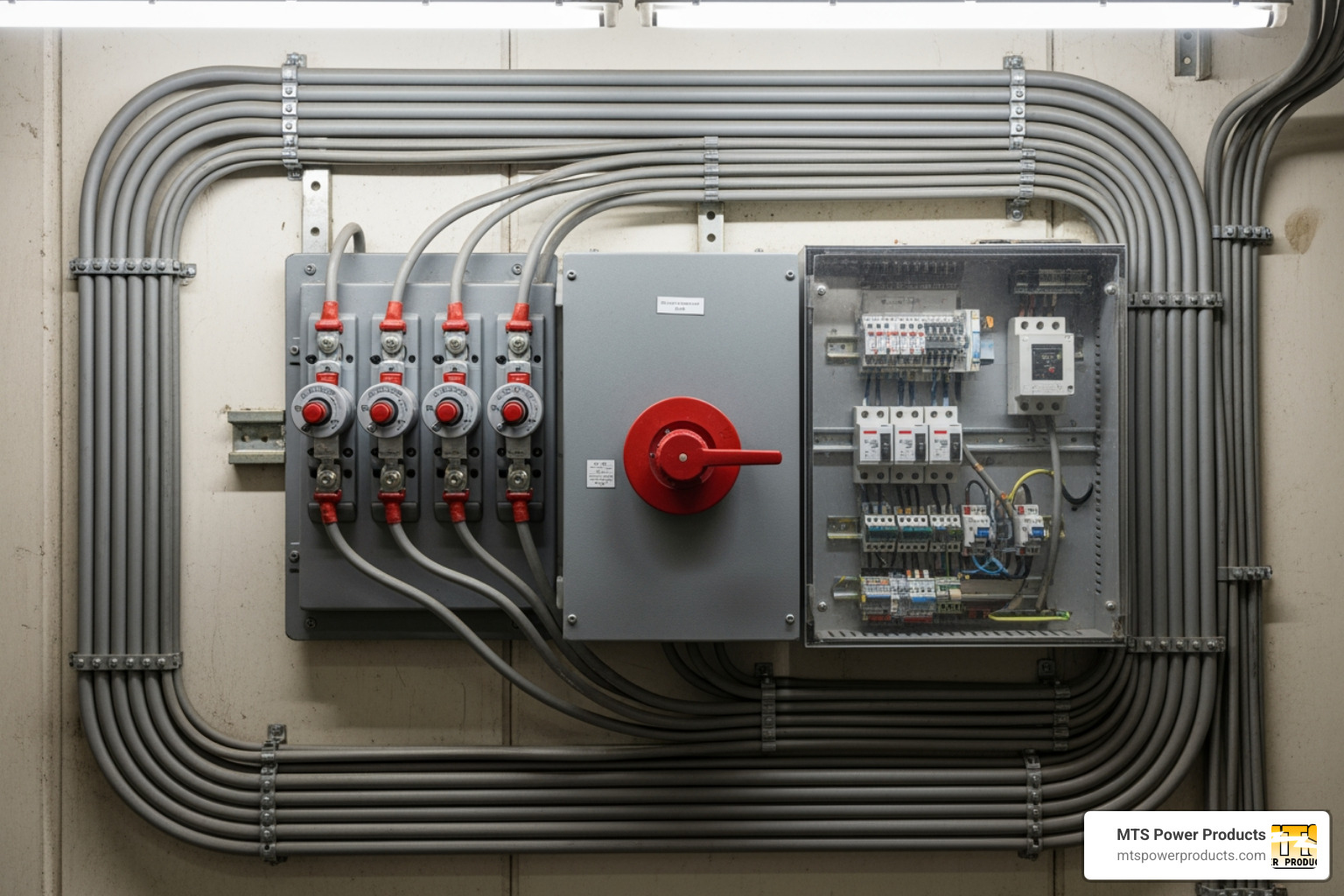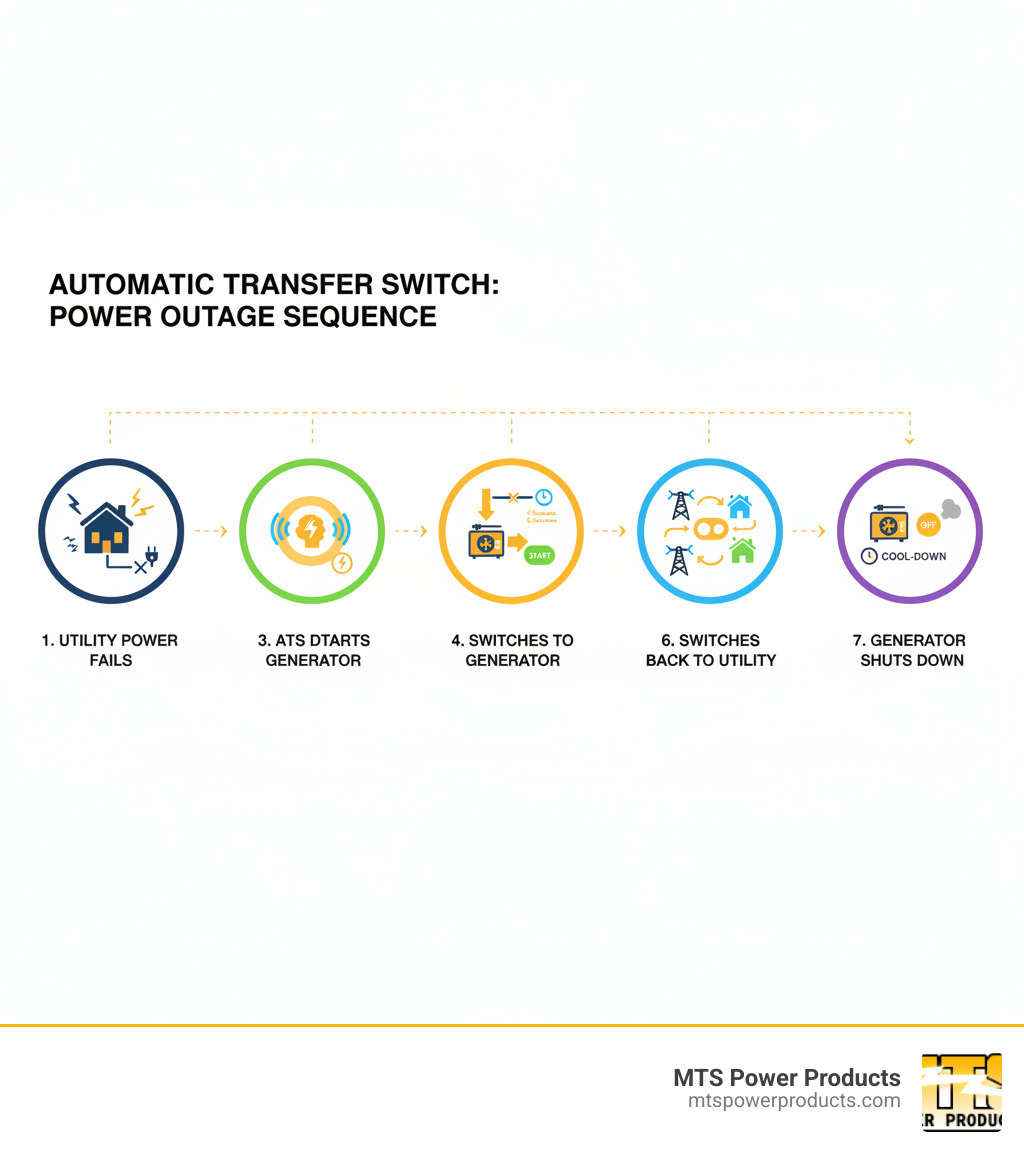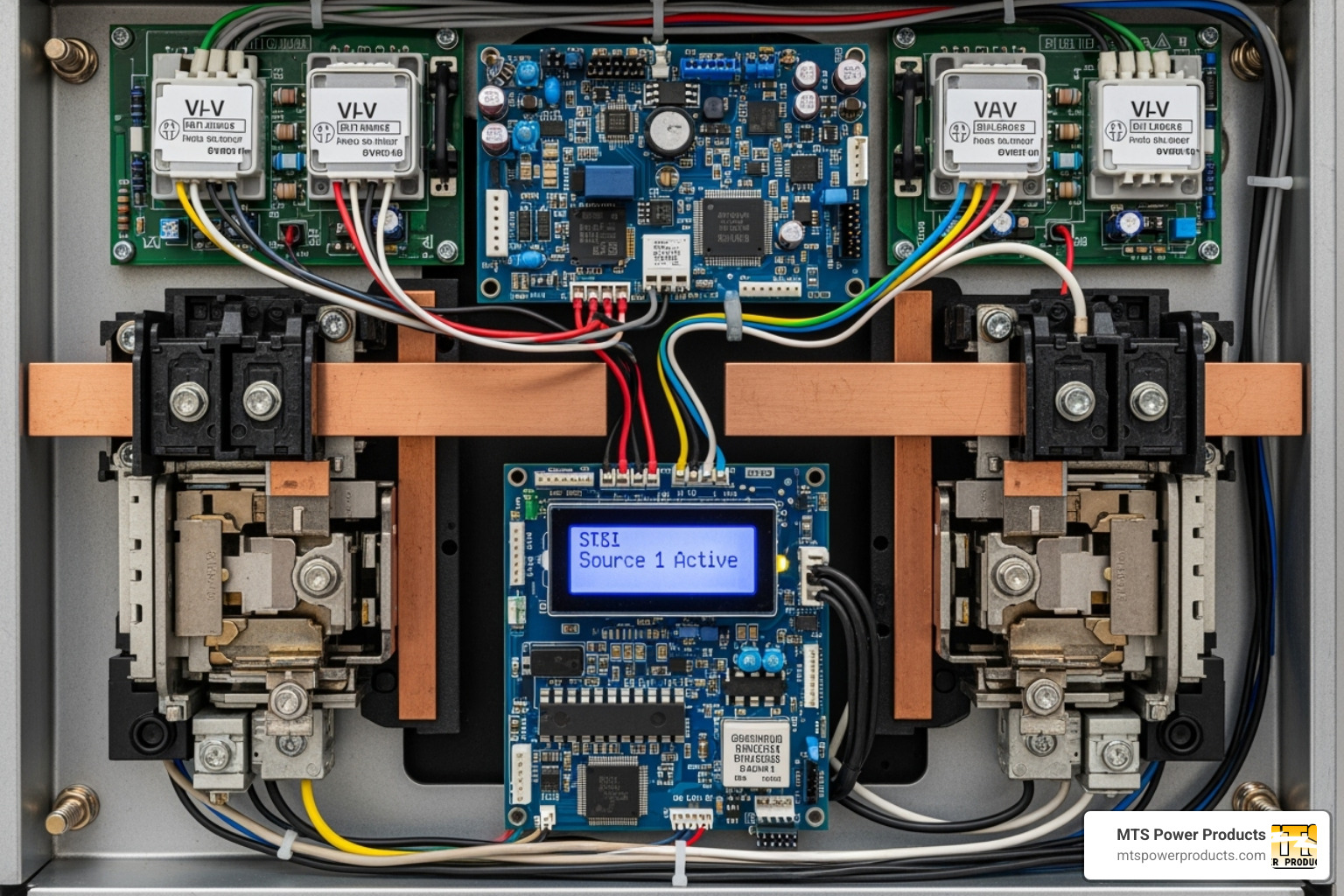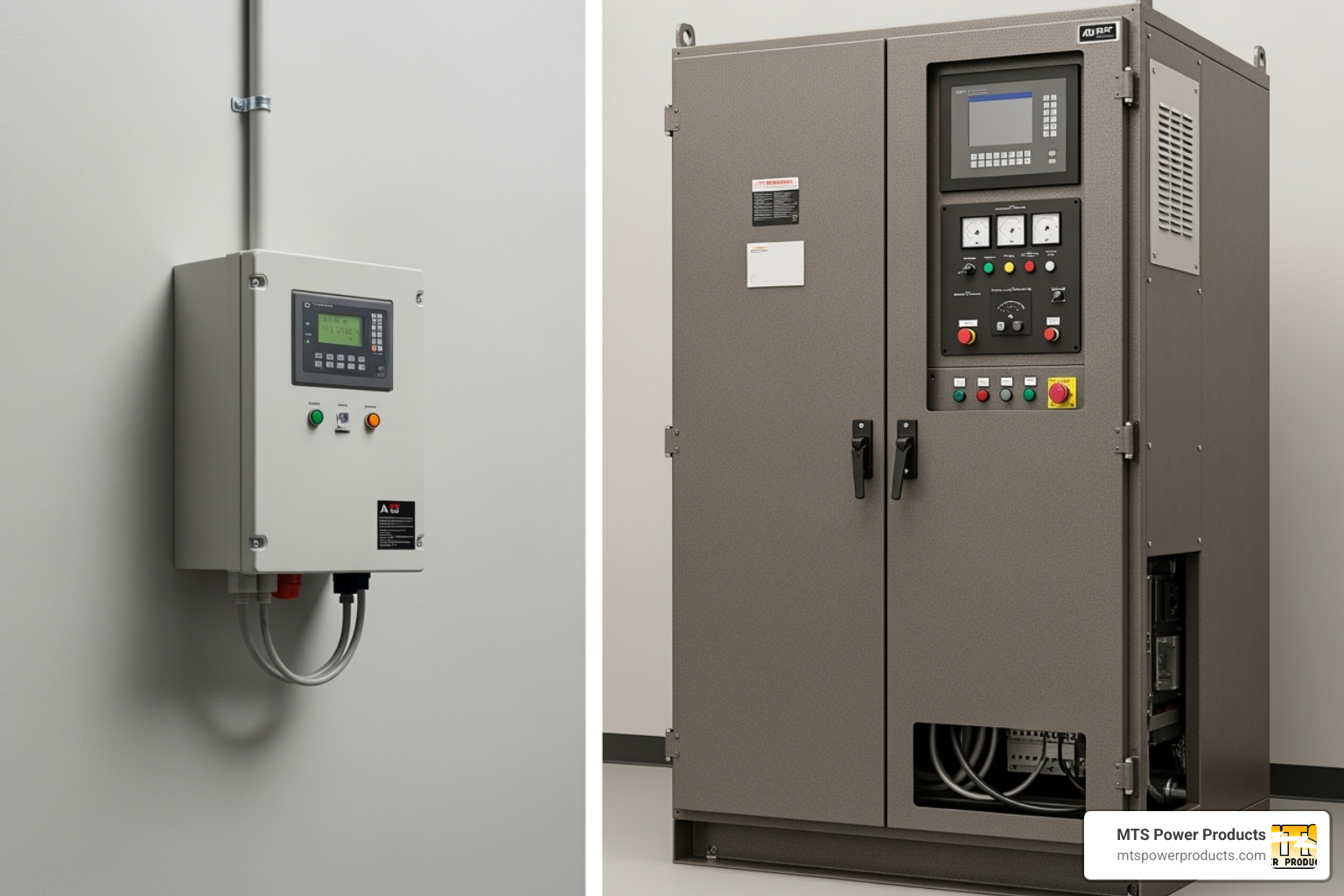
Buy Direct
from the Manufacturer
Sell our Products
Become a Distributor
Discounts
on volume purchases
Visit Us
at our Miami office
from the Manufacturer
Become a Distributor
on volume purchases
at our Miami office
What is an automatic transfer switch for a generator? An automatic transfer switch (ATS) is a device that connects your generator to your home or business’s electrical system, automatically switching between utility power and generator power when outages occur. It acts as the “brain” of your backup power system, ensuring continuous electricity without any manual intervention.
Quick Answer:
It’s a common misconception that a standby generator can just plug into a wall outlet. The reality is far more sophisticated—and much safer.
Without an ATS, you’d have to manually disconnect from the grid and connect to the generator. This process is inconvenient, dangerous, and often illegal due to the risk of backfeeding electricity into power lines. An ATS eliminates the guesswork and safety risks of manual power switching, which is critical for both manufacturing operations and homeowners preparing for hurricane season.
The automatic transfer switch continuously monitors your utility power’s voltage and frequency. When it detects a problem, it starts your generator and seamlessly transfers your electrical load. When utility power returns and stabilizes, it switches you back and shuts down the generator after a proper cool-down period.

Terms related to what is an automatic transfer switch for a generator:
An automatic transfer switch is the brain of your backup power system. It acts as a smart middleman, constantly monitoring utility power and ready to switch to your generator when an outage occurs. Its primary function is to ensure continuous power delivery by mediating between the grid and your standby generator, making sure your lights stay on.
Crucially, an ATS is a safety device that prevents “backfeeding.” This dangerous event occurs when a generator sends power back into utility lines, creating a deadly electrocution risk for workers. The National Electric Code® mandates transfer switches for this reason.
Our McPherson Controls ATS units are designed with these advanced safety features built right in, protecting both your family and the hardworking folks who keep our power grid running. You can dive deeper into this process in our guide on How Automatic Transfer Switch Works.
Imagine the power going out at 2 AM during a hurricane. With an ATS, you might not even notice. It detects the outage, starts your generator, and transfers power—all without you lifting a finger. This is the key benefit of automatic operation.
This seamless transition is critical for medical equipment, sump pumps that must run during a storm, and business operations where downtime means lost revenue. An ATS provides reliability for critical systems that manual switching can’t match. There’s no stumbling in the dark or forgetting to switch power back when it’s restored.
The convenience during an emergency reduces stress, as you won’t have to act like an electrician in dangerous conditions. Learn more about getting prepared with our guide: Prepare with an Automatic Generator with Transfer Switch.
Skipping a transfer switch is dangerous and illegal. Backfeeding occurs when a generator sends electricity back into the utility grid, creating a hidden danger for workers who assume lines are dead. The electrocution risk for line workers is a tragic reality. Using a generator without a proper transfer switch puts their lives at risk as they work to restore power.
Backfeeding can also damage your generator from power surges when utility power returns and create fire hazards from uncontrolled electrical flow. The bottom line is that connecting a generator to your home without a proper transfer switch is illegal in most areas. Electrical codes mandate them for safety, protecting lives and property.
Let’s look at how an automatic transfer switch works. An ATS must react instantly to power failures while making calculated decisions to protect your equipment.

The core of an ATS is its microprocessor-based controller. This digital brain continuously monitors utility power, measuring voltage and frequency to detect any signs of trouble. When it detects a blackout, unsafe voltage drops, or frequency fluctuations, the controller initiates a precise automatic sequence.
The ATS follows a precise sequence to ensure safety and protect your equipment:
Understanding what is an automatic transfer switch for a generator means getting familiar with its key components:
There is no one-size-fits-all automatic transfer switch. The right ATS must match your specific power requirements and budget.

Residential and commercial needs differ significantly. Commercial applications require more robust features, higher amperage capacities, and advanced controls for critical industrial loads. Our Automatic Transfer Switches for Commercial applications are engineered for these demands.
The switching mechanism is the heart of the ATS, physically making and breaking electrical connections.
The transition type—how the ATS switches power sources—is a critical choice depending on your equipment.
Proper sizing is crucial. An undersized ATS won’t handle the load, while an oversized one is a waste of money.
Sizing by amperage is based on your electrical needs. Residential units are typically 50-400 amps. For a whole-property backup (service disconnect), the ATS amperage must match your main electrical breaker (e.g., a 200-amp breaker needs a 200-amp ATS).
You’ll also need to decide between whole-house coverage and critical circuits only. Load center switches power 8-16 essential circuits. Service disconnect switches back up the entire property at a higher cost.
Cost varies by need. Manual switches are $300-$500. Automatic residential units fall in the $400-$800 range. Commercial models range from $2,000 to $20,000 or more.
At MTS Power Products, we understand that every power solution needs to fit both your electrical requirements and your budget. Our Miami-based team can help you find the perfect match. For detailed cost breakdowns and sizing guidance, check out our comprehensive guide on How Much Does an Automatic Transfer Switch Cost?.
Choosing between an automatic and manual transfer switch is a key decision in your backup power strategy. The experience is very different, though both serve the same core safety function. Both safely connect your generator and prevent backfeeding, but their operation, convenience, and applications differ greatly.
| Feature | Automatic Transfer Switch (ATS) | Manual Transfer Switch (MTS) |
|---|---|---|
| Operation | Automatic detection and switching; no human intervention required. | Manual operation via a lever or switch by a user. |
| Best For | Standby generators, whole-house backup, critical applications. | Portable generators, essential circuits, budget-conscious users. |
| Cost | Generally higher ($400-$20,000+), but offers greater convenience. | Generally lower ($300-$500), requires manual effort. |
| Safety/Convenience | Highest safety (prevents backfeeding automatically), maximum convenience. | Safe if operated correctly, but requires user presence and action. |
| Generator Type | Primarily for standby generators. | Primarily for portable generators, often with an interlock panel. |
The choice depends on your lifestyle, budget, and need for convenience. For those who travel, rely on medical equipment, or want peace of mind, an ATS is worth the investment.
The difference is one of sophistication and convenience. An ATS provides automatic operation, acting as a silent guardian. It monitors utility power 24/7, and during an outage, it automatically starts the generator and transfers the load, keeping your power on even if you’re away or asleep.
The seamless transition is often just a brief flicker of lights. Appliances and security systems continue to run without interruption. While there is a higher cost ($400 for residential, up to $20,000+ for commercial), it buys peace of mind and prevents costly disruptions. An ATS is ideal for standby systems, turning a generator into a fully automated power security solution.
Manual transfer switches require you to be present to act. During an outage, you must go outside, start your portable generator, and then manually flip the switch at your electrical panel. The process must be reversed when power returns.
Manual operation offers complete control and a lower cost ($300-$500), making it accessible for tighter budgets. It’s a common, practical choice for safely connecting portable generators.
At MTS Power Products, we see both types as valuable solutions for different situations. Our McPherson Controls automatic transfer switches offer the ultimate in convenience and reliability, while manual options provide a cost-effective way to safely connect portable generators. The choice depends on your specific needs, budget, and how much you value the convenience of truly automatic backup power.
Here are answers to common questions about automatic transfer switches and how they fit into backup power plans.
Many portable generator owners ask about using an ATS. The short answer is: it’s complicated, but sometimes possible. Most ATS units are designed for auto-start standby generators. Since portable generators require manual starting, a standard ATS won’t work.
However, some ATS models are compatible with portable generators. They will detect an outage and alert you to start the generator manually. Once you plug it into an inlet box, the ATS handles the power transfer automatically.
Safety is crucial. This setup requires proper equipment and professional installation by a qualified electrician to prevent backfeeding and ensure compatibility. For more detailed information, check out our ATS for Portable Generators page.
Even the most reliable ATS needs regular testing to ensure it works during an actual outage. NFPA standards recommend weekly or monthly testing for most homes and businesses. Critical facilities like hospitals test more frequently.
Load testing, which simulates real-world conditions by running the generator under load, is vital. Many of our McPherson Controls units have built-in, schedulable self-test features.
Testing simulates an outage to verify the entire sequence: detection, generator start, load transfer, transfer back, and generator shutdown. This identifies failures before an emergency. Ensuring reliability requires documenting tests and addressing issues immediately, much like regular car maintenance.
Yes, a permit is required to install a transfer switch in almost every jurisdiction. This ensures safety and compliance with electrical codes. Local electrical codes vary, but all consider transfer switch installation a major electrical modification.
A licensed electrician is required for this complex installation. They ensure proper sizing, safe connections, code compliance, and prevention of backfeeding. The permit process, usually handled by your electrician, involves plan submission, inspections, and final approval. This protects you from liability and ensures safety standards are met.
Requirements vary by jurisdiction, so consult a local electrician who knows the specific rules for your area. Skipping permits can lead to fines, insurance issues, and safety hazards. Professional installation is not worth the risk.

An automatic transfer switch provides peace of mind, keeping your home or business powered during a storm. We’ve covered how an ATS is the brain of your backup system. The key takeaways are safety (preventing backfeeding), reliability for essential systems, and the peace of mind that comes with uninterrupted power.
An ATS transforms your generator into an automatic power security system, crucial for hurricane season or continuous business operations. It eliminates worries about fumbling in the dark or critical equipment like medical devices and sump pumps failing.
At MTS Power Products, we help families and businesses secure their power independence. Our McPherson Controls line features innovative and safe switches with programmable displays for advanced control and monitoring. They are sophisticated power management systems designed to keep you connected to what matters most.
Located near Miami’s airport and port, we serve customers worldwide. As South Florida locals, we understand the need for reliable backup power.
Don’t wait for the next outage. Professional installation by a licensed electrician is key for safety and code compliance. Ready for complete power security? Explore our complete selection of Generator Automatic Transfer Switch solutions and see why we are South Florida’s choice for custom power solutions that actually work when you need them most.
